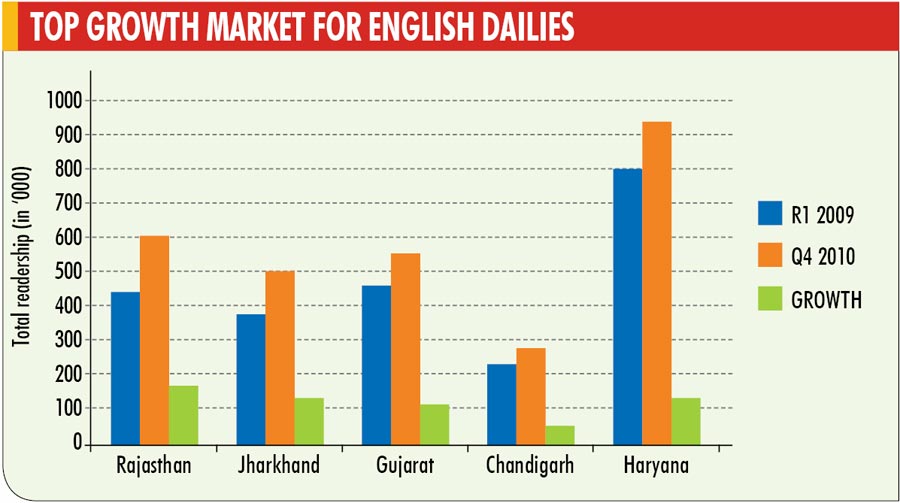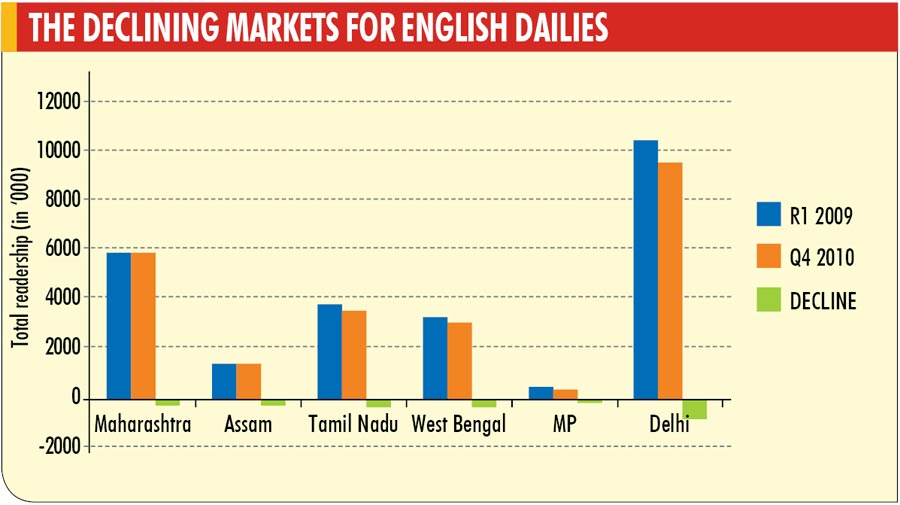Here the blog comes to give you the wealthy information about today's business world, and interesting marketing updates.
17 March 2011
IRS
IRS 2010, Q4: Hindi belt laps up the English press
Amongst the Hindi speaking states, Rajasthan has shown an increase of 37 per cent in readership of English dailies in the last two years.
Except for Delhi and Goa, the penetration of English print in most states is below 7 per cent. However, what's encouraging is that in the Hindi speaking markets, the English press is slowly strengthening its grip, albeit in small numbers.
In between R1, 2009 and Q4, 2010, English dailies have registered growths in total readership in all Hindi speaking states, except for Delhi and Madhya Pradesh (MP). The best part of this is that the English dailies have recorded double-digit growths in eight of the 13 Hindi speaking states.

In Rajasthan, where the penetration of English print is as low as 1.26 per cent, English dailies have registered a growth of 37 per cent in the last two years. In 1992, The Times of India (TOI) had shut down its Jaipur edition, though it continued to reach the readers through a Delhi edition printed in Jaipur. However, the Rajasthan market experienced a spurt in June 2008, when DNA was launched in the Pink City and the TOI also re-launched its Jaipur edition. Hindustan Times (HT), too, had shut down its Jaipur edition, but carried on with the distribution of the Delhi edition in the city - it still does the same.

The growth in Rajasthan could be attributed to the TOI and DNA. The TOI's readership has grown by about one lakh readers (from 3.3 lakh to 4.2 lakh readers) in two years. DNA, too, has doubled it readership since R2, 2009, when it was first reported.
English readership comes from Jaipur, which is fast becoming a well-read market because of various reasons including the annual Literature Festival, the royal population and the educated group which is interested in national and international news - a section which, to a large extent, is ignored by the local Hindi dailies.
In Jharkhand, the penetration of English dailies is slightly higher (2 per cent) in comparison to Rajasthan. In this industrial state, English dailies have registered a growth of more than 31 per cent (from 3.83 lakh to 5.04 lakh).
This market could see further growth for English dailies, provided they take this market more seriously. Till today, The TOI and HT print their facsimile editions from Ranchi, while The Telegraph is still considered as a West Bengal-oriented newspaper in the state.
Gujarat is another market where the penetration of English dailies is only 1.19 per cent. Here, too, English dailies have registered a growth of 21.59 per cent (from 4.54 lakh to 5.52 lakh) in two years. The spurt in this market also came from DNA and the TOI, as it happened in Rajasthan. DNA was launched in September 2007 from Ahmedabad and three months later, the TOI launched Mirror from the city. Both dailies gave the English readers a mix of soft news and opinion.
Amongst the North Indian markets (Punjab, Chandigarh, Haryana, Himachal Pradesh), Chandigarh, where the penetration of English dailies is very high (31 per cent), has registered a growth of 21 per cent. In Haryana, the growth rate has been 14.69 per cent, while in Himachal Pradesh, the growth rate has been 7.17 per cent. This growth can be considered to be organic because there were no significant launches in these markets.
In Punjab, English dailies have grown at a slower pace during the period - 3.87 per cent - despite the fact that Hindustan Times has been aggressive out here. In November 2010, it introduced dedicated local pages for five locations in Punjab, including Patiala, Bathinda, Jalandhar, Amritsar and Ludhiana. Following this, the paper, which was reaching out to the readers of these five cities through a replica of the Chandigarh edition, also has content tailored to the needs of the local populations of the five cities.
For this, the group has spent Rs 11 crore in upgrading the machinery in Chandigarh and has also installed a printing facility at Jalandhar to reach these five cities.
Interestingly, the national capital, where English dailies have the highest penetration, is the biggest loser in terms of growth percentage. Any English daily in Delhi, having readership of 9.64 crore, has lost 6.7 lakh readers since R1, 2009. Any English daily has registered de-growth of 6.5 per cent.
It is one of the rare markets where both the TOI and HT have registered declines. While TOI is the biggest loser and has lost 3.62 lakh readers during the period, HT has lost about 1.39 lakh readers in Delhi.
The two tabloids, Mid-Day and Mail Today, which were introduced in Delhi in 2007, were of not much help either in stabilising the numbers.
However, experts believe that the decline in readership in Delhi is not a matter of concern for the planners - plus or minus 5 per cent doesn't make a difference for Delhi.
In MP, too, English dailies have shown a decline of 6.43 per cent - in a market where English dailies penetration is already the lowest at 0.5 per cent. However, the launch of the TOI could change things in the market. Besides, HT has started consolidating its position in Madhya Pradesh. As part of this, the daily introduced a printing facility in Indore in May 2010, which will later culminate into an edition.
Subscribe to:
Comments (Atom)

